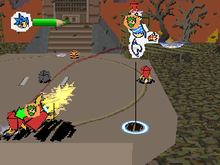Rakugaki Showtime
 From Wikipedia - Reading time: 7 min
From Wikipedia - Reading time: 7 min
| Rakugaki Showtime | |
|---|---|
 | |
| Developer(s) | Treasure |
| Publisher(s) | Enix |
| Director(s) | Tetsuhiko Kikuchi |
| Designer(s) | Naoki Kitagawa Tetsuhiko Kikuchi Tsunehisa Kanagae |
| Programmer(s) | Hiroshi Matsumoto Masaki Ukyo |
| Artist(s) | Gō Nakazawa Kazuo Yasuda |
| Composer(s) | Norio Hanzawa Toshiya Yamanaka Kanta Watanabe |
| Platform(s) | PlayStation |
| Release |
|
| Genre(s) | Fighting |
| Mode(s) | Single-player, multiplayer |
Rakugaki Showtime[a] is a 1999 fighting game for the PlayStation developed by Treasure and published by Enix. It is a full 3D battle arena fighting game, featuring characters that resemble crayon drawings. The game was only released in Japan.
Gameplay
[edit]
Rakugaki Showtime is a fighting game in a full 3D fighting arena.[1] It features up to four players.[1] Throwing projectiles feature prominently in the game, which has led to some reviewers comparing the game to being similar to dodgeball, but lacking a dividing line between the teams.[1] The game features 17 playable characters, including guest character Marina Liteyears from Mischief Makers.[2]
Development and release
[edit]Rakugaki Showtime was Treasure's first original project for PlayStation.[3] It featured music composed by Kenta Watanabe, who had previously worked on Banpresto's Panzer Bandit (1997).[4] The game was released on 29 July 1999, and published by Enix.[5] The game was given a very limited release because of a legal dispute over who owned the characters between Enix and Treasure.[6] The game became a rare item after its release, and would sell for 15,000 yen ($150 U.S.).[7] It was re-released for the PlayStation Network "Game Archives" in Japan on 25 June 2008.[8] It retailed for 600 yen.[9] The game was to be the basis for the GameCube and PlayStation 2 fighting game based on Tiny Toon Adventures, called Tiny Toons: Defenders of the Universe,[6] but the game was never released. It was later leaked onto the internet.[10]
Reception
[edit]Rakugaki Showtime was met with positive reception from critics.[7][13][14][15]
Notes
[edit]References
[edit]- ^ a b c Kalata, Kurt (12 July 2017). "Rakugaki Showtime". Hardcore Gaming 101. Archived from the original on 19 November 2020. Retrieved 16 January 2021.
- ^ Bevan, Mike (19 June 2008). "Full of Eastern Promise". Retro Gamer (52): 36.
- ^ Griffin, Mike (September 1999). "Cover Story - Game Profile: Rakugaki Showtime; An Interview with Masato Maegawa - Founder and President, Treausre; Text Continued". Gamers' Republic. No. 16. Millennium Publishing. pp. 17–18, 124.
- ^ Manent, Mathieu (1 February 2018). PlayStation Anthology. Geeks-Line. pp. 30–32. ISBN 979-1093752334.
- ^ a b "NEW GAMES CROSS REVIEW: ラクガキショータイム". Famitsu (in Japanese). No. 555. ASCII Corporation. 6 August 1999. p. 29. Archived from the original on 18 November 2015. Retrieved 27 August 2018.
- ^ a b Fahs, Travis (7 May 2008). "Beta Blues, Vol. 2 - Games snatched away from us at the last minute: Conspiracy Theory". IGN. Ziff Davis. p. 2. Archived from the original on 22 March 2016. Retrieved 27 August 2018.
- ^ a b Davies, Jonti (2 July 2008). "Japanese PlayStation Store Gems - Jonti reckons Sony is doing a great job managing the Japanese PlayStation Store..." GameSpy. IGN. p. 1. Archived from the original on 27 December 2010. Retrieved 16 January 2021.
- ^ "プレイステーション3のゲームアーカイブスに『ゼノギアス』や『アストロノーカ』など6タイトルが追加". Famitsu (in Japanese). Kadokawa Corporation. 25 June 2008. Archived from the original on 4 September 2016. Retrieved 27 August 2018.
- ^ Gibson, Ellie (25 June 2008). "Square Enix releases old games via PSN - But only for the Japanese Store". Eurogamer. Gamer Network. Archived from the original on 16 November 2012. Retrieved 27 August 2018.
- ^ Spencer (4 March 2009). "Lost Treasure Developed Tiny Toons Game Found". Siliconera. Curse LLC. Archived from the original on 5 February 2010. Retrieved 27 August 2018.
- ^ Ngo, George (November 1999). "Imports: Rakugaki Showtime". GameFan. Vol. 7, no. 11. Shinno Media. pp. 82–83.
- ^ Bartholow, Peter (12 October 1999). "Rakugaki Showtime (Import) Review - Those looking for a great party-game fix should give Rakugaki Showtime a look". GameSpot. CBS Interactive. Archived from the original on 29 July 2018. Retrieved 27 August 2018.
- ^ Bevan, Mike (19 June 2008). "Full of Eastern Promise: Rakugaki Showtime". Retro Gamer. No. 52. Imagine Publishing. pp. 36–37.
- ^ "Hidden Japanese Gems - How to infiltrate the Japanese PlayStation Store, and pick up an array of 32-bit classics and rarities!". IGN. Ziff Davis. 29 April 2009. p. 1. Archived from the original on 20 January 2019. Retrieved 16 January 2021.
- ^ Miller, Patrick (11 February 2016). "17 mold-breaking fighting games that all developers should study". Gamasutra. UBM Technology Group. Archived from the original on 31 July 2018. Retrieved 16 January 2021.
 KSF
KSF